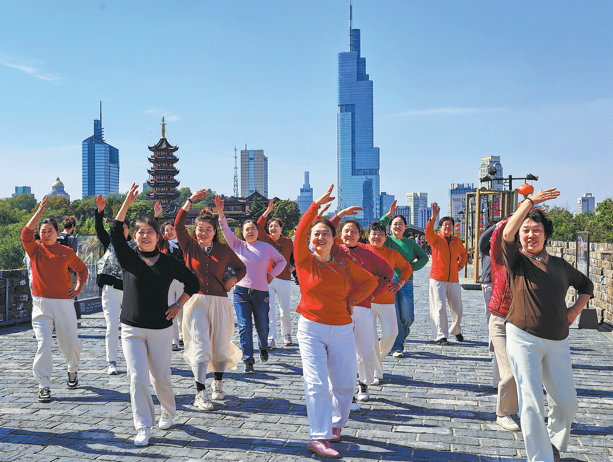From walking to whirling, seniors show their moves at squares


SHENYANG — As the last rays of the setting sun fell on a riverside park in Shenyang, in Northeast China's Liaoning province, music filled the air and the park square became a dance stage as dozens of elderly women began their nightly exercise.
Waving a pair of fans, 63-year-old Hui Furong danced in a neat formation, a big smile on her face. Six years ago, Hui underwent surgery for stomach cancer and said she hadn't felt like herself. Her friend, Huang Fengzhen, invited her to join the dance group, telling her she needed to face the disease with a positive attitude.
In the months that followed, Hui joined the group daily, and gradually her appetite returned and her weight normalized.
Hui and Huang are among tens of thousands of elderly Chinese who consider square dancing part of their daily routine.
China's population aged 60 and above reached 310 million by the end of last year.
Known as guangchang wu in Chinese, square dancing is a group open-air exercise set to music. Participants are mostly middle-aged or retired, and it is especially popular among women.
Wang Haifeng, a professor at the Shenyang Conservatory of Music's Dance Academy, notes that this type of dance benefits participants' physical and mental health and fosters team spirit.
Its origins are hard to trace. In Northeast China, Wang notes, it could have stemmed from the spirited Yangge dance, which is native to the region.
"In the 1980s, choreographed group dances emerged, which might have been a rudimentary form of square dancing," he says.
Huang started working in a community in the Tiexi district of Shenyang in the 1960s and witnessed community cultural and sports activities emerge and grow over the decades.
"With societal development and improved living conditions, demand for culture and sports among the elderly is growing rapidly," she says.
She began organizing local square dances about a decade ago. At the beginning, these activities mainly involved walking after dinner, with groups of three to five people stretching their arms and legs. One member later brought a tape recorder, and music turned the exercise into full-fledged square dancing.
While exact numbers are difficult to determine, multiple organizers estimate that about 10 percent of locals participate in square dancing. Applied nationwide, this suggests roughly 100 million dancers.
On why square dancing is popular among elderly people, veteran dancer Xu Guoliang in Yiyang, Central China's Hunan province, says it is an opportunity for people to showcase their talent.
"Many people dream of dancing on stage, and square dancing is the easiest way to make those dreams come true," he says.
Many Chinese women, particularly in rural areas, spend years taking care of their children and extended families. When they get older and their children start their own families, Xu says, they finally have the chance to rest and pursue their own happiness.
"I've seen women start shyly, then gradually join the group," he adds. "Elaborate costumes give confidence to women who normally dress plainly."
He Lixin, head of a square dancing group in Liaoning, emphasizes that the activity meets elderly social needs. "After retirement, many feel down and bored staying home. Now they come every day, and their children thank us for enriching their lives."
Most dancers in He's group were born in the 1960s or 1970s and enjoy nostalgic songs from their youth. "Square dances with revolutionary-era music bring back memories and connect people with shared experiences," he says.
Wang observes that square dancing reflects lifestyle changes. "With improved livelihoods, people are now free from worries about food and clothing. Their main concern now is their physical and mental health, and dance is a way to boost both."
Once controversial for noise complaints, square dancing now attracts more participants, including young people.
A survey conducted by the Hubei Masses Art Center in 2023 saw about two-thirds of respondents express a positive attitude toward square dancing, with the strongest support among those born in the 1960s and 1990s.
Liu Rong, vice-head of the Jiangsu provincial square dance sport association, has choreographed more than 800 dances.
"After the televised Spring Festival Gala each year, new songs quickly become new dances," she says.
Meanwhile, square dances are increasingly incorporating elements of professional dance, local opera and folk music.
At the national square dancing competition last year, dancers from South China's Guangxi Zhuang autonomous region took the silver medal with a dance adapted from a traditional folk song of the local Zhuang ethnic group.
The dance was choreographed by a Guangxi University teacher, and the costumes used Zhuang brocade, recognized as a national intangible cultural heritage.
"We want to tell Guangxi's stories through square dancing, letting audiences see Zhuang ethnic culture," says Qiao Mingyue, the group's head coach.
Back in Shenyang, Huang's group has expanded to nearly 90 members, incorporating local artistic forms like Yangge and fan dancing.
Although the grandmother is now 89 years old, she still appears brisk and energetic. "I can still lead our members to have healthy and happy lives," she says.



































